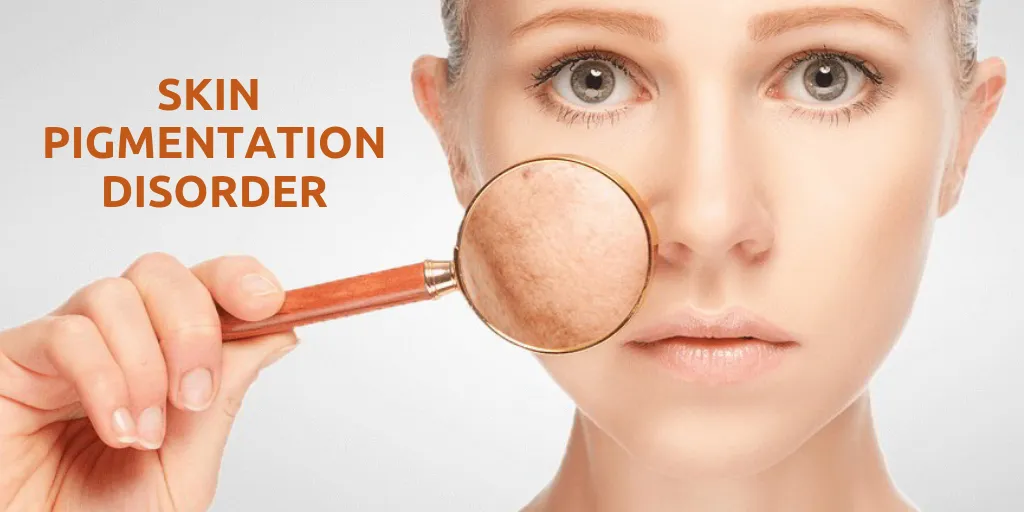
Skin pigmentation disorders can be due to changes in melanin. Melanin is a skin pigment produced by melanocytes situated in superficial layer epidermis, gives color to the skin, hair, and eyes. Melanin composition differs, fairer skin has a low composition and darker individuals with a high composition of melanin.
Skin discoloration is described as any change in the natural skin color like darkening, lightening, or reddening. Any type of cuts, scratches, trauma, or burns can also result in skin discoloration.
Skin pigmentation disorders affect the color of your skin.
When these cells become damaged or unhealthy, it affects melanin production; either increase or decrease in and called respectively as:
Hyperpigmentation is due to an increased amount of melanin pigment which represents a darker skin color. Further, it classified depending upon the area of involvement;
Here the skin becomes darker or gets hyperpigmented over the entire body with symmetrical involvement. Addison Disease ( 95% of patients) prominently involving pressure areas, skin folds, and within the oral cavity. Haemochromatosis(in 90% of patients) prominently involving the genitals, skin folds, and sun-exposed areas. Metastatic melanoma though it’s rare.
Drug: In people treated with afamelanotide.
Localised pigmentation may be due to melanin, haemosiderin or externally-derived pigment
Few conditions to be considered are:
Hypo or depigmentation may be due to partial or complete loss of melanin pigment in the superficial layers of skin. Further, it classified depending upon the area of involvement;
Generalized reduction in melanin pigmentation usually seen in a congenital or racial problem such as albinism. Albinism is a birth defect in which there is a complete loss of pigmentation in skin, hair, and eyes. Pallor or paleness of the skin is noticed in acute blood loss or severe anemia.
It can be congenital or acquired. They are represented as single or multiple pale or white patches. Following conditions to be considered:
1. Excessive sun exposure: Excessive sun exposure can cause an increase in melanin and results in tanning. It results in hyperpigmentation of the exposed skin.
2. Skin damage or diseases: Due to damage to skin results in the melanocytes producing excess or decrease melanin. Skin disorders such as dermatitis, pimple, or any infection can lead to the recovery of even skin tone after the damage. As a result of this, the skin shades over the affected area becomes lighter or darker.
3. Hormonal change: Hyperpigmentation is a direct result of an increased level of a hormone in your body that results in increased melanin synthesis. Pregnancy or during puberty or contraceptive pills, the hormone levels are affected and cause the increase in melanin production leading melasma in some women. Addison’s disease can produce hyperpigmentation mostly on the exposed areas of sunlight, such as the face, neck, and hands, and areas exposure to friction, such as elbows and knees.
4. Certain medications: as afamelanotide, non-steroidal medications, antibiotics, anti-epileptic drugs, or topical retinoids and chemotherapy drugs can cause hyperpigmentation as a side effect.
5. Hypersensitive reactions: An allergic hypersensitive reaction to an allergen may cause skin irritation and stimulates the melanocytes to causes hyperpigmentation.
6. Genetic: in some, it may be genetically inherited to cause pigmentation. Hence it is important to protect from sunlight or skin damage.
7. Post skin procedures like chemical peels, phototherapy, or laser treatment can cause hyperpigmentation.
Diagnosis: It is more of a clinical diagnosis but Wood’s lamp examination is done to differentiate various pigmentary disorders from infectious diseases such as fungal and bacterial infections, lice and nits, erythrasma.
| DO | DON'T |
|---|---|
| Use regularly a broad-spectrum sunscreen (> SPF 30) | Do not get overexpose to sunlight |
| Take an expert opinion at the early stages | Do not go outdoors without sunscreen |
| Better avoid excessive sun exposure | Do not get sunburns as they may lead to skin cancer |
| Use physical sun protection like muffler and caps | |
| Use an umbrella, wear full sleeves clothing or broad-brimmed hats on outdoors |
The treatment depends on the cause and condition you are treating. If pigmentation due to melanin affects an exposed site, the use of sunscreen SPF 50+ will minimize darkening caused by exposure to sunlight. This is may not be so effective for melanin residing in the dermis or to reduce pigmentation caused by drug or tattoo.
The following agents are used to lighten epidermal melanosis, alone or in combination to enhance the results:
Chemical peels, microdermabrasion, q-switch lasers, resurfacing fractional lasers, intense pulsed light (IPL) may be effective but need experts in the field of dermatology to handle. Cryotherapy and electrocautery for small areas of pigmentary problems such freckles can be handle with caution.
Cosmetic camouflage using make-up is the best way, for people who try to avoid interventional therapy.
The treatment depends on the cause and condition you are treating, but still, most of the hypopigmentation due to inflammatory skin disorders and infections usually resolves by itself over the time period once the underlying disorder is treated. The response of vitiligo is topical steroid, tacrolimus, and immunomodulators and phototherapy in resistant cases.
